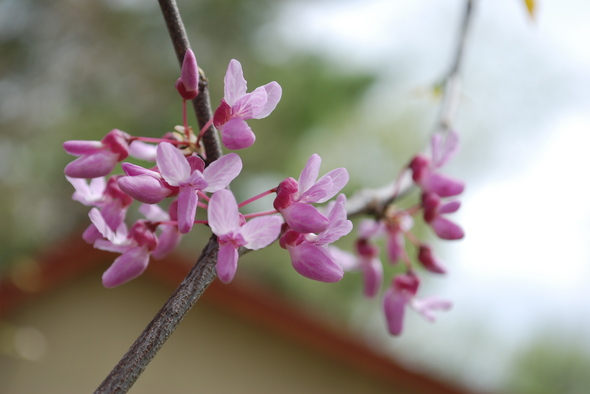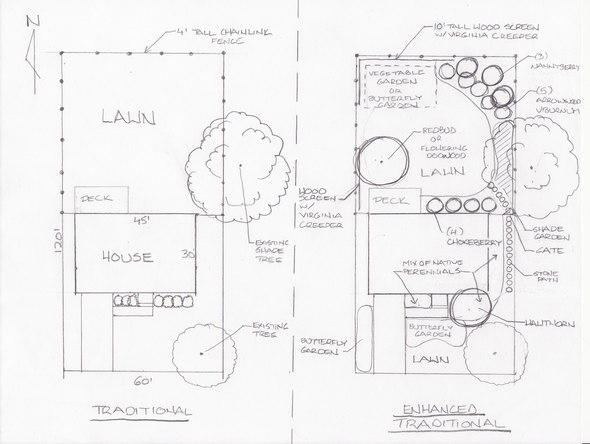Smaller yards can be converted into a paradise of native plants

The beautiful flowers of Eastern Redbud (Cercis canadensis) brighten up any yard in spring.
Rick Meader | Contributor
This entry is dedicated to my brethren whose yards, like ours, are geographically challenged.
Larger yards present great opportunities for expansive vistas teeming with natives, rolling terrain and perhaps even multiple habitats.
Smaller yards present opportunities for hearing your neighbor’s conversations and smelling their lawnmowers’ exhaust. But, smaller yards can also be big time savers on maintenance and present the opportunity for cozier, more intimate spaces that invite you out to learn the native plants you own on a first-name basis. They also don’t have to be budget busters as fewer plants are needed to make an impact.
So, let’s get down to converting a standard small lot to a native paradise.

Two landscape plans for the same lot - one, a fairly common, traditional lot and the second, with natives added to create privacy, interest, and a more welcome port of call for songbirds, hummingbirds and butterflies.
Rick Meader | Contributor
First, let’s look at the typical lot in question: not too fancy, just a basic 60 foot x 120 foot (1/6 acre) lot, with a large shade tree on your neighbor’s yard and a small tree in the front yard.
The house has a 30x45-foot footprint, with a nice deck in the back to take in the beauty of a large, lawn back yard with lots of lawn, a four-foot tall chain link fence to keep it all contained and some yews in front to hide the foundation. There's not a native to be found, unless the tree out front is a native maple or oak species. As a result, there probably aren’t many birds hanging out in the yard either.
For fun, let’s assume that we want to add some privacy to this yard and that we want to use natives to do it. First, we want to consider the sun that’s available. In this case, we’re in pretty good shape because we’ll be getting a lot of sun from the south and west as the shade tree is east of our property and there are no significant shading elements to the west.
Next, let’s assume that the soils aren’t particularly sandy so the soil can retain some moisture, which impacts the plants you can use. But, being a small lot, presumably in an urban setting where septic fields are not required, it probably isn’t swampy, either. Keep all of this in mind as we work on our lot.
Let’s look at the back yard first, as the deck seems to need some privacy in order to truly enjoy it. While the fence keeps the dogs in and kids out, or vice versa, it provides no privacy.
One option would be to erect a wood lattice screen along some sections of the fence (not all) to provide a softer visual screen than a solid fence would give, and then plant Virginia Creeper (Parthenocissus quinquefolia) along the base for it to climb up the lattice. The leaves would provide denser cover in the summer when the deck is being used and turn a great color of red in the fall. Additionally, the berries would be great, native bird food.
Since this corner would get great southern exposure, you could put in a vegetable or flower garden or a butterfly garden in front of the lattice.
In the northeast corner, two layers of viburnums, Nannyberry (Viburnum lentago) and Arrowwood Viburnum (Viburnum dentatum) would provide a softer, vegetated screen for that corner of the lot and would also provide fall color and food for birds. Native plants with good shade tolerance such as Wild ginger (Asarum canadense) could complete the picture with a good groundstory cover.
Along the eastern side, under the shade tree, a collection of native perennials with tolerance of partial shade could soften up that border and its view of chain link fence. Some smaller shrubs, such as Black chokeberry (Aronia melanocarpa) could be planted along the rear foundation, and finally, a native ornamental with an open character, such as Flowering Dogwood (Cornus florida) or Eastern Redbud (Cercis canadensis) could be planted north of the deck to softly break up the view to the back and provide some protection from cooling breezes from the north.
In the front yard, we could rip out the yews and replace them with sun-loving native perennials between the front door and the driveway and add a smaller ornamental such as a hawthorn (Crataegus spp.) between the house and the existing tree, with native perennials that like shadier conditions underneath it.
The great sunlight in the front yard gives a great opportunity for butterfly gardens that can also attract birds who love the seeds in the fall. Finally, the eastern side of the house, with its greater width, provides enough space for a native garden along the foundation as well.
While this wasn’t the goal of this plan, which was to increase privacy, the additional plants and gardens also reduce the amount of lawn that needs to be mowed on a regular basis, freeing up some time to enjoy the newly private deck even more. And, as you can see, even smaller lots can have a good native footprint and can be useful tools for increasing the privacy of your lot, while also providing a more inviting place for songbirds.
So, take heart, my fellow small lot-dwelling suburbanite: You can make your home feel more like home with the help of natives.
Rick is a local landscape architect with a special interest in all things natural, including native plants and the critters that eat them. You can contact him at yourland1824@gmail.com.


Comments
A2K
Tue, Mar 29, 2011 : 2:21 p.m.
We've slowly been redoing our A2 yard with native flowers, shrubs, and grasses, but it took us 3 years to eradicate the evil, heinous Buckthorn. We have fairly good-sized pines and maple, with some smaller shrubs and trees surrounding our average-size backyard, so oodles of songbirds, woodpeckers, and 4 kinds of squirrel.
Rick Meader
Tue, Mar 29, 2011 : 12:31 p.m.
Debb, Unfortunately, quite difficult. They have tough, impressive root systems. I'd recommend digging out as much dirt as you can and then cutting the roots with a saw. I had one in my back yard that I pulled out that had at least 8 strong roots going every which way. It's worth the effort, but it is effort. Thanks for reading.
Deb Burch
Tue, Mar 29, 2011 : 11:14 a.m.
I like the idea to rip out the yews and replace them with sun-loving native perennials near the front door. If they are older plants/shrubs, how difficult would it be to move them?
Rick Meader
Tue, Mar 29, 2011 : 3:52 a.m.
Thanks for your comment, Shrewd! The nice thing about shrubs is that a lot of them grow fairly quickly, so you can get a smaller one and it will do nicely. Also, if you have patience, smaller plants can save you money. Wildtype Nursery in Mason, Michigan is a great source for native shrubs, and native trees as well. They may not be 8' tall, but they'll be Michigan genotype, and his plants' survival is great. Check them out! <a href="http://www.wildtypeplants.com" rel='nofollow'>www.wildtypeplants.com</a> Rick
shrewdrealist
Mon, Mar 28, 2011 : 9:10 p.m.
Good call on the Hawthorn; not to often you see them in the home landscape. V. lentago makes a good ornamental tree as well, it can take the form of multistem C. canadensis or multistem Crataegus. Most nurseries don't market Viburnums as trees when they can easily do it. You can go to Christensens and get an 8' magnolia but the biggest V. plicatum is 36". Looking forward to the season!